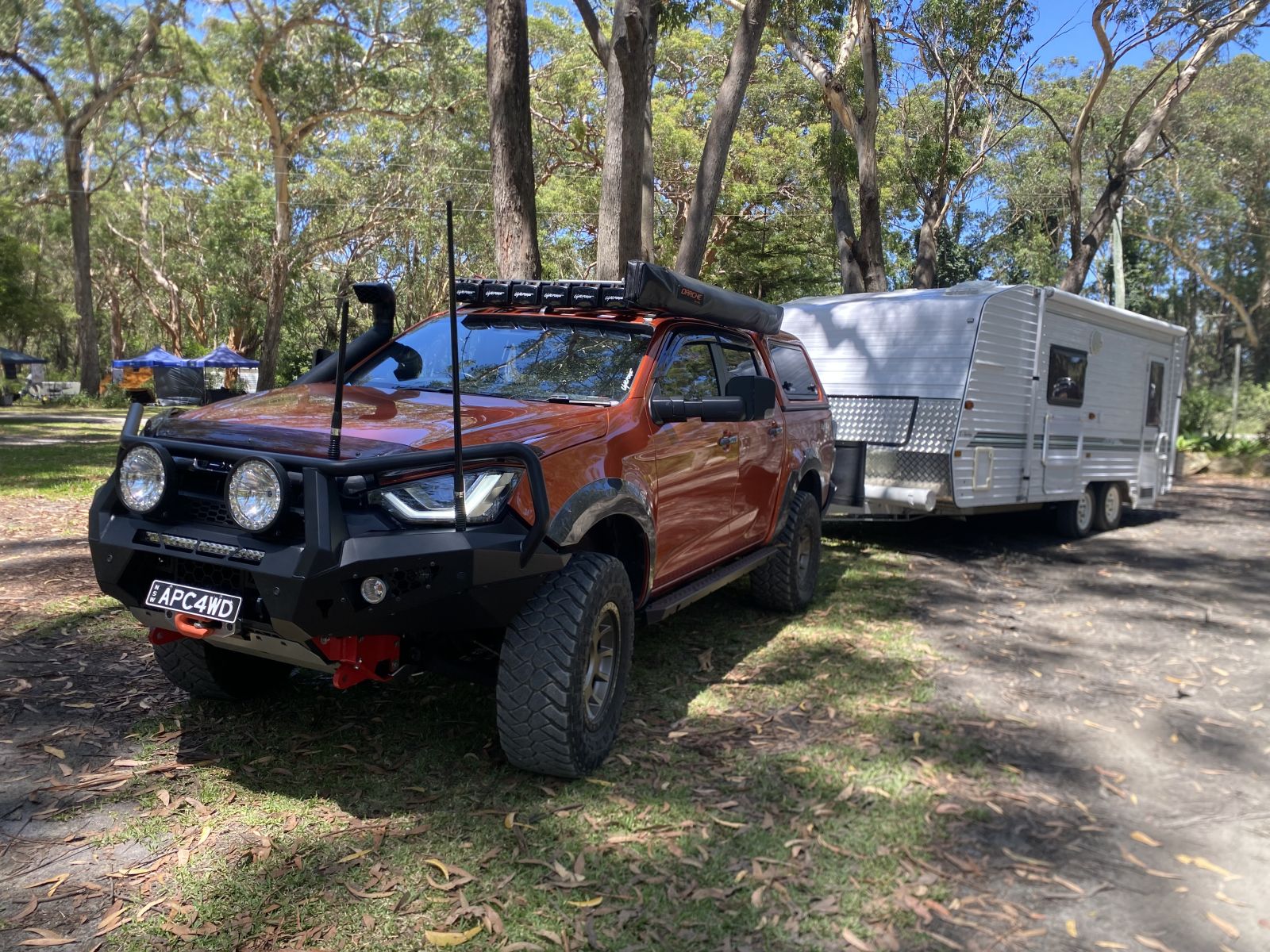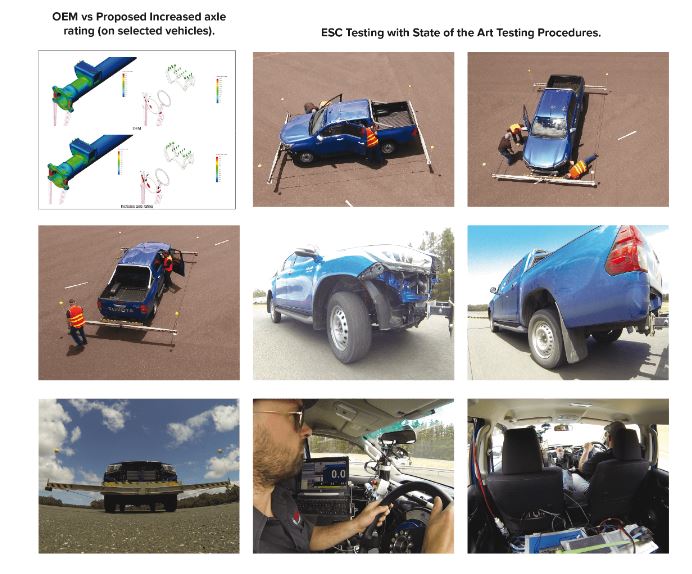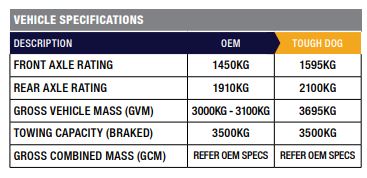Lets talk GVM Kits
Author: Jason Date Posted:4 January 2024
Let me start with saying that we don’t sell or install GVM kits, but we see a big need for education around them.
We are seeing a lot of people ordering their new Vehicles with a GVM or GVM/GCM Kit fitted pre rego without properly looking into their needs before doing it.
We are also seeing a lot of those vehicles in posts on the various pages online being driven around empty with no accessories fitted looking terrible and causing problems.
Why do most people GVM upgrade their Vehicles?
The most common reason is generally to Tow, or you are building it into a Super Heavy Touring rig, or both like ours pictured.

The first question to be asked if you are doing a GVM kit just to tow a heavy Caravan etc is:
Is Towing weight “Constant” weight?
Generally that answer is almost always 99.99% of the time a No.
“Constant Load” means “Constant Load” not “Occasional Load” and this is by far the No1 biggest mistake people make when setting up their vehicle
Unless you need to do a GVM/GCM Kit Pre-rego to up your combined mass for Towing, we strongly recommend setting the vehicle up how it is going to be used before entertaining the idea of installing a GVM Kit & then I would spend the time doing the research on what kit will best suit your needs.
If you are going for a GVM upgrade only, it can be done pretty easily at any stage Post Rego.
There are a lot of things to consider BEFORE deciding on doing a GVM Kit and also which GVM Kit to go with.
Nearly all GVM Kits are designed to be loaded at MAXIMUM weight 100% of the time.
All of the Pre-Rego GVM/GCM Kits are definitely done this way.
They use both the Heaviest available Coil springs and Leaf Springs for the Vehicle in the kits.
They have to do it this way if you are purchasing a kit like these, as the assumption is that you are about to Max the vehicle weights out beyond the original GVM of the vehicle.
If the Weight going onto the Vehicle is “Constant” and the vehicle is at or near GVM this is no issue, but if the weight comes on and off, or you aren’t going to add a lot of Accessories to the Vehicle this kind setup is going to cause you big problems on any Vehicle.
It is especially a big problem for the New Vehicles being driven out of the Dealership with no accessories on them looking like a ski ramp sitting way high up in the back and too high in the front as well as this causes massive issues.
For a Rear end with a full GVM Spring setup in an empty vehicle it can raise the rear end sometimes anywhere from 4-5” or 100-125mm.
Besides riding with all the comfort of a housebrick on wheels, it pushes the shocks to the point that they will have very little downtravel or droop left.
You can also induce massive driveline vibrations and things like brake hoses will be just about maxxed out and in a lot of cases, the ABS wiring will be running out of length too.
For a Front end with a GVM Kit installed and no extra accessories, especially on modern IFS vehicles, they can be left with almost no Droop and top out the Struts or Shocks and essentially jack hammer them to death over every speedhump or decent bump in the road. Steering Geometry and wheel alignment will also be badly compromised.
We have seen front ends come up easily 3-4"from factory height, so over 2" or 50mm further than intended when set up with no weight over the nose.
If you have a vehicle that is going to be built and loaded to the hilt all the time, a GVM Kit with the heaviest of everything will be fine for you in 99% of situations.
On some vehicles like the new D-Max and BT-50 Platform these issues become worse, as there are big problems with Bump Steer and rapid tyre wear at anything over about 50mm of lift currently.
If you have a Vehicle that does a lot of Towing, but also a bit of running around town not Towing you really need to look at your options before purchasing a GVM Kit, as a GVM Kit with a softer set of Leaf Springs and possibly a set of Airbags for the additional support when Towing may be a far better option than a Max Weight Kit.
How are GVM Kits Done?
All suspension companies that do GVM upgrade kits will look at the maximum permissable axle weights stated by the vehicle manufacturer and then design their GVM Kit to be close to or right up at those maximum weights.
Manufacturers will have Maximum permissable axle weight that will be under the maximum loads the weakest part of that axle is capable of handling.
The weakest part may be the pick up points on the chassis, differential housing, wheel bearings, wheel studs, ball joints, steering components or any of the other components related to either the front of rear axles.
Take the 08/2020-Onwards Isuzu D-Max or Mazda BT-50 for example:
From the factory the GVM on the Vehicle is 3100kg & Tough Dog have been able to upgrade this to 3695kg.
.Tough Dog have achieved this by going close to Maxxing out the highest permissable axle weights from Isuzu & Mazda to achieve the upgraded GVM rating.
Maximum Axle Weights:
A consideration when upgrading your vehicle and adding accessories or towing loads is the maximum axle weights permissable on the vehicle.
It is quite easy to still be under your GVM or GCM, but be over the maximum allowable weight allowed on an axle group.
For example, a Ute with a Canopy that is all built out in the back with Batteries, Fridge, equipment etc, a Rooftop Tent, on top & then a heavy Towing Ball Weight could easily put a back axle load over ther maximum permissable weight, with the vehicle still being under GVM and GCM.
We always recommend planning out your build and knowing the weights that are in your vehicle.
Here are some of the Calculations I did when fitting out our own vehicle:
2020 D-Max X-Terrain:
Factory Tare Weight 2130kg
GCM 5950kg
GVM 3100kg
Max Towing 3,500kg
Max Ball Weight 350kg
Weighbridged Vehicle on 21-12-20 & Tare weight was 2180kg with approx 30kg of Diesel on board
Vehicle was almost Stock, with only a few accessories installed and Aftermarket Wheels and Tyres fitted.
Aftermarket Accessories & Weights added to vehicle with Max Fuel Load = 832kg
2nd Battery 14kg Lithium
ARB Canopy Kit 85kg Minus 45kg for Factory Roller Shutter & Tub Liner
Drawers 114kg
Drawer Contents 30kg
Fridge & Contents 45kg
Fridge Slide 35kg
Sliders 54kg …. Minus 6kg for Factory Steps
Bullbar 65kg …. Minus 11.6kg for Factory Bar and Impact Beam ….
Airbag Kit & Compressor 12.5kg
Roof Rack kit with Low Mount 20kg
Alloy Bash Plates 25kg
Lights 11.6kg
Rear Bar 45kg ... Minus 5kg for Factory Bar
Fuel Tank 43kg …. Minus 5kg for factory tank
Fuel weight at Max Capacity of 132ltrs is 109kg
Other Accessories inc all wiring, brackets etc 196.5kg
Weighbridged Vehicle again & the Total Finished Vehicle Weight with a full tank of Diesel on board and all accessories = 3012kg
This was without a Driver or any Passengers on board.
This only left 88kg to Maximum Factory GVM of 3100kg, which meant that it could not legally carry anyone other than the Driver on board & certainly could not Tow anything at all, even though putting the Caravan on still left the vehicle well under the GCM of 5950kg
Weights for our Caravan:
TARE 2280kg
GVM 2420kg
ATM 2700kg
Weighbridged Van at 2518kg loaded & ready for a trip.
CARAVAN BALL WEIGHT = 326kg
Adding the Ball Weight of the Caravan to the vehicle takes the Weight of the vehicle from 3012kg to 3338kg, as the Ball Weight of what you are towing is included in the weight of your vehicle.
Without even having a Driver or Passenger in it, just by hooking the Caravan up took our vehicle 218kg over GVM with 420kg still left in GCM & left us with no choice but to do a GVM Upgrade.
Now with a 3600kg Dobinsons GBM Upgrade installed in the vehicle, we are well under GVM and still have 240kg left to GCM all loaded up for a trip with Driver and Passenger on board.
Pricing on GVM Kits
A lot of people complain about the cost of purchasing a “GVM Kit” and the fact it is dearer than a normal Lift Kit even though it often uses the same part numbers available off the shelf.
There are a few things that need to be understood here.
It costs a Suspension Manufacturer in the vicinity of $70,000-$100,000 to put a kit for each and every vehicle through the Engineering, Testing and Certification process.
You then need to realise that as a Vehicle Manufacturer does updates to the Vehicle itself in its lifespan these GVM kits need to be adjusted and recertified as well.
The Process to get each single Vehicle through GVM Certification is huge.
Each and every Suspension and Steering Component like Ball Joints, Wheel Bearings, Axle Housings & Chassis Pick up point must be tested.
Nowadays this has been made a lot easier thankfully by computer modelling & manufacturer data being able to be sourced so they can test components to ensure they are going to be able to cope with the additional stresses and loads that will be placed on them.
Many of these things you don’t even give a second thought to like Ball Joints, Steering Arms, Wheel Bearings, Axles and the performance of the Braking System.
You just have to accept the costs involved with the engineering and certification process the Suspension Manufacturer has gone to for this kit to be approved for you to be able to carry more weight in your Vehicle.
This allows them to supply and install a kit to your vehicle with a known list of exact part numbers and the engineer knows the outcome of Swerve, Stability Control and Brake testing with those exact parts fitted.
This negates the need to hire a facility like a Racetrack and do all the testing on each and every vehicle each time a kit is installed, which is what you’d have to do if you pieced together your own kit and wanted to have it GVM approved.
Sure you can go and buy the parts separately yourself to make your own GVM Kit and end up with the same part numbers in your car, but if you haven’t purchased the “Engineered Kit” off the GVM Supplier you will be up for the expense to hire the facilities to have all of this testing done & the expense of an engineer for yourself.
You will end up spending Thousands more to do it this way in the end.
The image below shows some of the testing required for GVM kits for a manufacturer to have a kit approved.

In saying all of this, we have recently installed a GVM Upgrade kit in our own Current Shape New Shape Gen 3 Isuzu D-Max to take it from 3100kg to 3600kg GVM.
GCM for towing was not an issue in our situation, so doing it Pre-Rego was of no benefit to us.
We built the vehicle to how we wanted it as a Tourer / Towing setup, adding all the accessories first and then weighed it. I was a little surprised when it came in as heavy as it did at 3012kg with 131 Litres of Diesel on board.
This was without even a Driver in it. Add a Driver and a Passenger and it was way over maximum GVM of 3100kg.
We did our research and looked at what each manufacturer was doing with their GVM Kits before leaping.
As mentioned earlier most GVM Kits are purely the heaviest of everything thrown at it to cope with Maximum Loads.
This was not going to suit us as even though our vehicle is within 88kg of GVM, the “Constant” Rear Load in it is only around 250-260kg.
Only when towing, do I add another 300kg of ball weight to the Rear, and could use those super heavy 450kg or 500kg Constant GVM Leaves.
For instance on the new D-Max & BT-50 platform Dobinsons are offering their GVM Kits with either their 280kg or 450kg Constant Load Leaf Springs. Bilstein and Tough dog are offering their GVM kits with either the 300kg or 500kg Constant Leaf Springs.
On most vehicles it gives you a lot more flexibility to suit your specific needs on a vehicle that isn’t always loaded to the hilt.
Dobinsons don't charge a Premium for the GVM Kit. They only charge Parts, Labour & the Engineer costs to supply Certification and sign off on the vehicle specific kit.
A few manufacturers are now offering their GVM Kits with multiple Leaf Spring and Coil spring options & this gives a lot of flexibility for end users.
Dobinson’s went through the process of doing the testing on the new D-Max/BT-50 Platform with each shock combo they manufacture & this gives you 4 different Kits to choose from.
They have done the kits on these particular Vehicles with the option of a 40-70kg Front Coil and a 70-100kg Front Coil & for the Rear you can option a 250kg “Constant” Leaf or a 450kg “Constant” Leaf.
This gave us the option to go with the 250kg Leaves for optimum day to day setup and run Airbags in it for the extra load carrying capacity needed when Towing.
Tough Dog have gone a similar route with 2 Rear Leaf options at 300kg & 500kg on these models, but only the one Heavy Front Coil option.
Bilstein have their kits submitted for approval for these models at present and have gone with 2 Leaf options as well.
Kits like these three mentioned above give you much more flexibility to set the GVM kit up more to your needs & end up with a much better result.
I added Airbags to the back of mine to cope with the additional ball weight when towing & this is honestly the only way to set it up correctly for both rear weight loadings that the vehicle must deal with on a regular basis.
So that also moves us onto Airbags which I have touched on in my “How to set up your suspension correctly” blog on the APC4WD website.
Airbags:
Note: Airbags do NOT break Chassis, People break Chassis.
This usually happens by far overloading vehicles, often with Aftermarket Trays or Canopy Setups that are far longer than recommended for the vehicle, and then trying to pump the airbags back up to get it level again.
An all too common example of how chassis breakages occur:
Vehicles that the owners have already loaded up & running at full GVM, then you hook a Trailer which adds more weight over the rearmost point of the chassis, puts the vehicle way over GVM and they just pump the bags up and kill the poor thing......... Then blame the Airbags for snapping the grossly overstressed chassis.
Like anything.... Use them properly within the load limitations of the vehicle and they are perfect for what they are designed for.
A Classic Example of what we have mentioned is the image below.
Airbags did NOT break this vehicle, poor setup and overloading broke it.

What are we trying to say in all of this?
Do it once, and do it right.
We always try to tell people to set the car up first with all of your accessories, and then do the Suspension Kit to suit it last.
This is the Only way to set it up correctly to ensure proper load carrying ability, ride quality and optimised suspension travel.
This will always give the best results, as no matter how many times we try, people will order heavy springs for something they plan on doing weeks, months or years down the track...... Then they spray the Supplier or the Suspension company online saying how s**t the Suspension is & how terrible it rides, when in all reality the vehicle has just been set up poorly through bad choices.
I guess what I’m getting at with all of this is that if you aren’t going to add a lot of weight in Accessories and have “Constant” weights on your Vehicle, you are going to hate your vehicle and do damage to the expensive components you have just payed for and probably more to the car long term… It’s a real juggling act to get it right, so do your homework and do the mods once.



